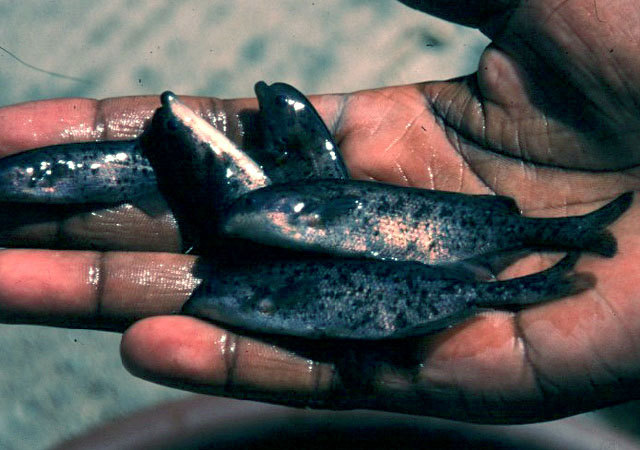| Africa: Lower Zambezi River from the delta upstream to at least Tete, if not Victoria Falls, and the lower Shire River; also Pungwe, Buzi and Mulela Rivers (Ref. 75962). Also upper and central Congo basin (Ref. 3203, 95585), Lake Rukwa basin (Ref. 95585), and east flowing rivers of Tanzania and Natal (Ref. 3203). Widespread and common in the Cunene and Okavango systems (Ref. 7248). Reports from Pool Malebo (Ref. 41585), the middle Congo River (Ref. 4910) and the Lulua (Kasai drainage)(Ref. 42554) possibly refer to M. angolensis. |
|
Dorsal spines (total): 0-0; Dorsal soft rays (total): 20-24; Anal spines: 0-0; Anal soft rays: 26-31. Diagnosis: Marcusenius macrolepidotus is best distinguished from M. altisambesi by the number of circumpeduncular scales, which is 12-18 vs. 12-14, and an electric organ discharge lacking an initial head-negativity; from M. devosi by the number of scales in linear series along the lateral line row, which is 52-62 vs. 56-66, shorter caudal peduncle length, and weaker Namp of its electric organ discharge; from M. pongolensis by the number of scales in linear series along the lateral line row, which is 52-62 vs. 70-76, the umber of circumpeduncular scales, which is 12-18 vs. 16-20, a greater body depth, and longer Ndur of its electric organ discharge in females and juveniles; and from M. angolensis by its lower number of anal fin rays, being less than 31 vs. 33, and dorsal fin rays, being less than 24 vs. 26, and a higher number of circumpeduncular scales (Ref. 75962).
Description: Head with terminal mouth well in front of eye, mental lobe on lower jaw protruding beyond upper jaw; head and body dorsolaterally compressed (Ref. 4967, 13337, 75962). Dorsal fin situated about two thirds of standard length from snout, obliquely orientated, anteriorly higher and posteriorly lower, proximal tip rounded, distal tip sharply pointed, distal margin sometimes only slightly crescentic with anterior two or three rays longer than posterior rays, number of rays 20-24; anal fin opposite dorsal fin with distinctly more anterior origin, obliquely orientated, anteriorly lower and posteriorly higher, anterior rays longer than posterior ones, especially in males where they also appear stronger and often darkened, distal margin crescentic, number of rays 26-31 (Ref. 75962). Scales cycloid with reticulate striae, scales extending anteriorly to operculum and pectoral fins; scales on caudal peduncle circumference, 12-18 (Ref. 75962). Caudal peduncle relatively deep, subcylindrical entire length, 17-21% of standard length (Ref. 75962). Electric organ discharge biphasic lacking a weak pre-potential, Pdur around 183 µs, Ndur around 174 µs, Pamp and Namp of similar strength (Ref. 75962).
Colouration: Colour in life: back and sides grey-silver, dark on the back and lighter on the sides, to very fair on the underside, gold-olive or purple shimmer depending on angle of light incidence, dark-grey blotches on sides and on unpaired fins, especially on the tail, but absent on head and belly, area next to first ray of anal fin darker, less distinct in females (Ref. 75962). Colour in preservation: blackish-brown on back, fading into ochre on lower body parts, light ochre on underside, blotches seen in life less distinct in preservation (Ref. 75962). |

